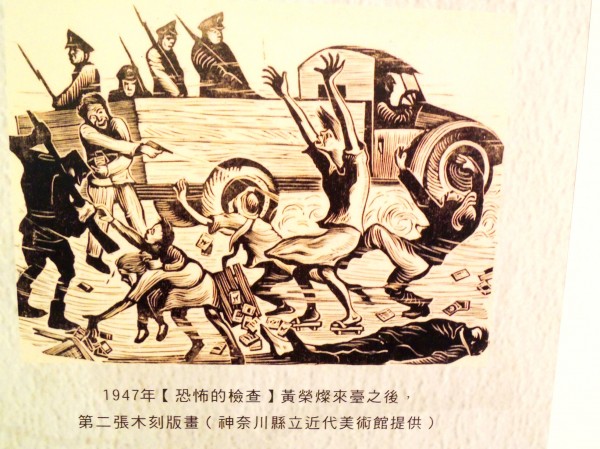《TAIPEI TIMES 焦點》 Exhibition featuring wooden carvings depicting 228 Incident visits Tainan

The outbreak of the 228 Incident in 1947 is depicted in a contemporary woodcut by Huang Rongcan titled Horrifying Inspection. Photo: Tsai Wen-chu, Taipei Times
POLITICAL CLIMATE: The artwork being displayed sheds light on the power struggles in Taiwan during the 1940s when the KMT first arrived from China
By Tsai Wen-chu and Chen Wei-han / Staff reporter, with staff writer
An exhibition featuring Chinese wood engravings depicting artistic representations of Taiwan around the time of the 228 Incident is currently on display in Greater Tainan.
The exhibition presents artworks by Chinese expatriates who lived in Taiwan between 1945 and 1949, the years when Taiwan experienced a turbulent shift from Japanese colonial rule to the Chinese Nationalist Party (KMT) regime, the 228 Memorial Foundation said.
The 228 Incident, which began on Feb. 27, 1947, refers to an uprising against the then-Chinese Nationalist Party (KMT) administration, which led to the murder of thousands of civilians, and nearly four decades of martial law in Taiwan.
According to the foundation, the Chinese artists engraved Taiwan’s landscape against the background of contemporary society under the then-KMT regime.
Among them was Huang Rongcan (黃榮燦), an artist from Chongqing in China’s Sichuan Province.
An editor at a newspaper in Taiwan when the 228 Incident took place, Huang subsequently carved Horrifying Inspection (恐怖的檢查) in secret based on what he had heard from his colleagues, the foundation said.
Published in the Shanghai-based Wenhui Daily newspaper two months later, the piece became an iconic symbol of the massacre.
As the Chinese Civil War between the KMT and the Chinese Communist Party in China escalated, the political climate within Taiwan became increasingly volatile, prompting the artists to return to China, the foundation said, adding that since the KMT regime retreated to Taiwan and purged the island of “communist activities,” Taiwan has not seen any uncensored wood engraving since 1951.
The curator, Hung Wei-chien Studio, hunted through numerous collectors’ galleries to rediscover the precious artworks, whose artistic value is as significant as their visual documentation of the 228 Incident, the foundation said.
In addition to Huang’s engravings, the exhibition showcases nearly 100 artworks, including that of Zhu Minggang (朱鳴岡), Huang Yan, Wang Maigan (王麥桿), Huang Yongyu (黃永玉), Qiu Ling (邱陵), Wang Renfeng (汪刃鋒), Wu Zhonghan (吳忠翰), Zhang Xiya and Mai Fei (麥非).
The foundation said the exhibition had its opening at the National 228 Museum in Taipei last year, and was then held in Taitung, Hualien and Pingtung counties.
Its Tainan tour began on Saturday and is scheduled to run through Feb. 8.
新聞來源:TAIPEI TIMES

















